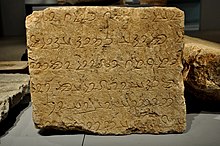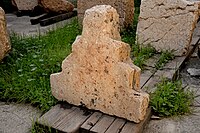Paikuli inscription
The Paikuli inscription (
In 293 Narses marched from Armenia in open revolt against his nephew with a host of supporters and allies, whose names are recorded on the Paikuli inscription.[4]
Background
The Paikuli inscription of Narses shows that

The fact of Amr ibn Adi's vassalage to Narses was preserved by the latter in the Paikuli inscription.[6]
Paikuli inscription may be devoid of much historical information because it belongs to the genre of epic literature composed since time immemorial in the ancient Near East.[7]
In the 19th century, when it was visited by several travelers, it consisted of the ruins of a large, square tower that had originally been covered on all sides by stone blocks, some contained inscriptions, but, at the time, lay scattered all around the monument.
Sassanians
In
S. Mori contends that the Paikuli inscription is basically relating the traditional Near Eastern story of how a king achieves supremacy with the aid of the gods in the epic form. He also believes that the early Islamic texts, such as al-Tabarī are of little use for the history of the Sasanian period.[8]
Gallery
The Sulaymaniyah Museum in Iraqi Kurdistan opened a new Gallery on June 10, 2019, dedicated to the Paikuli Tower, its inscription, and King Narseh. The Sulaymaniyah Museum is the only Museum which displays relics of the Paikuli Tower.[9]
-
Recently discovered C2 inscribed stone block, Middle Persian script, from the Sassanian Paikuli Tower, Sulaymaniyah Museum
-
Recently discovered c12 inscribed stone block, Parthian script, from the Sassanian Paikuli Tower, Sulaymaniyah Museum
-
A2 inscribed stone block, Middle Persian script, from the Sassanian Paikuli Tower, Sulaymaniyah Museum
-
d3 inscribed stone block, Parthian script, from the Sassanian Paikuli Tower, Sulaymaniyah Museum
-
One of the inscribed stone blocks from the Paikuli Tower of Narseh. Late 3rd century AD. Sulaymaniyah Museum
-
f7 block from the Paikuli Tower inscribed with Parthian language. Sassanian, reign of Narseh, late 3rd century AD. From Sulaymaniyah, Iraq. Sulaymaniyah Museum
-
Newly discovered f1, Parthian inscription, block from the Paikuli Tower of Narseh, Sulaymaniayh Museum
-
One of the non-inscribed rounded stone blocks from the Paikuli Tower of Narseh. Sulaymaniyah Museum
-
Newly discovered fragment of stone block G6, Middle Persian script, Sassanian Paikuli Tower, Sulaymaniyah Museum
-
One of the busts of the Sassanian king Narseh. Late 3rd century AD. From the Paikuli Tower, Sulaymaniyah, Iraq. Sulaymaniyah Museum
-
Recently discovered fragment of a braid of hair of Narseh's bust, from the Sassanian Paikuli Tower, Sulaymaniyah Museum
-
Part of Narseh headdress from the Sassanian Paikuli Tower, Iraq
-
Non-inscribed stone blocks scattered around the Paikuli Tower of Narseh. Sulaymaniyah Governorate, Sulaymaniyah Museum
-
One of the non-inscribed rounded stone blocks from the Paikuli Tower of the Sassanian king Narseh. Sulaymaniyah Museum
-
Non-inscribed building stone of the Sassanian Paikuli Tower of Narseh, Sulaymaniyah Museum
-
Bust of the Sassanian king Narseh, Sulaymaniyah Directorate of Antiquities
References
- ^ "پەیکوڵی: شوێنەوارێکی گرنگ... دەقێکی لە بیر کراو،". 2011 (in Kurdish): 11–36. Retrieved 25 December 2019.
- ^ Amin, OSM. "Visiting the Paikuli Tower Built by the Sasanian King Narseh". www.ancient.eu. Ancient History Encyclopedia. Retrieved 19 March 2015.
- ^ Jacob Neusner, A History of the Jews in Babylonia, Vol. 12, p. 3.
- ^ Alan K. Bowman, Peter Garnsey, and Averil Cameron, The Cambridge Ancient History, p. 494.
- ^ C. E. V. Nixon and Barbara Saylor Rodgers, In Praise of Later Roman Emperors: The Panegyric Latini, p. 69.
- ^ Joel L. Kraemer, Israel Oriental Studies, p. 21.
- ^ P.O. Skjærvø and H. Humbach, The Sassanian Inscription of Paikuli, Wiesbaden, 1983, p. 44.
- ^ "The narrative structure of the Paikuli Inscription," Orient 30-31 (1995): 182-193.
- ^ "Sapienza in Iraq: Italo-Kurdish Collaboration to Protect the Archaeological Heritage of Paikuli". Sapienza University of Rome. Retrieved 18 March 2020.
Further reading
- Cereti, Carlo G. (2021). "Narseh, Armenia, and the Paikuli Inscription". Electrum. 28: 69–87. S2CID 243513056.



















